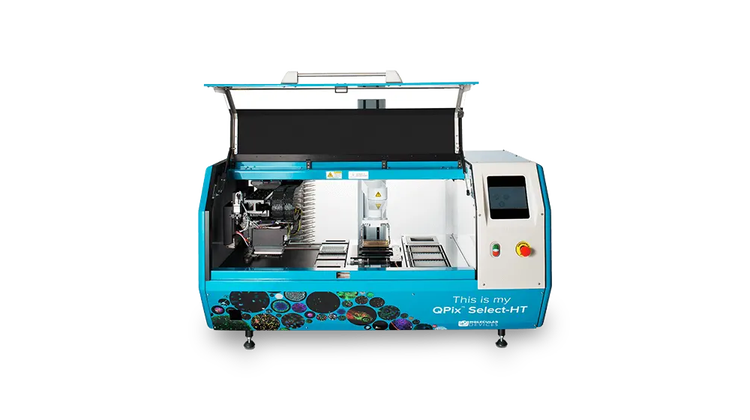automated-single-cell-dispenser-for-cell-isolation
Automated Single Cell Dispenser for Cell Isolation
Our compact automated single-cell dispenser system, DispenCell, offers gentle, quick, and easy single cell isolation, suitable for sterile hood or benchtop setups. It enables and streamlines single cell research for a variety of mammalian cell types.
Need help designing your solution?
Request a Quote
product
Mammalian Colony Pickers
We offer advanced mammalian colony pickers that are fully automated systems for the selection of high-value clones during colony formation in antibody discovery and cell line development workflows. Any specific cell types are imaged and picked, whether stem cells, hybridomas, or CHO cells, in accordance with a range of experimental parameters.
product
Microbial Colony Pickers
Our comprehensive microbial colony picker system is designed to automate your colony-picking workflows, enhancing precision and accuracy. It also reduces bottlenecks in the process of screening massive genetic libraries.
product
Single-Cell Imaging Systems
Our comprehensive single-cell imaging systems provide an automated solution for efficient and accurate single-cell detection, high throughput imaging, and data analysis during for cell biology workflows, providing deeper insights into the characteristics of mammalian cells or single cell populations.
Features
Key Features of Clone Screening Systems
Our products are developed using cutting-edge technologies to automate and streamline cell clone screening and picking. The integration of high-precision robotics with gentle fluidics-based systems allows a higher throughput (which means screening of more clones), the generation of stable cell lines, and easy monoclonal verification - maintaining consistent results throughout the process.
Some key features of our products include:
Microbial colony picker
- High efficiency colony picking, regional picking, plating, gridding, re-arraying, replicating, Fluorescence screening, blue-white colony screening, zone of inhibition based screening modules.
- Ultrasonic agar sensing ensures accurate colony picking
- WL + 5- Fl channel imaging
- High speed (3000 colonies/ hr) and high accuracy ( >95%) picking
- Multiple picking tools for diverse microbe picking
- Upgradable for workflow automation and integration
- Intuitive interface and software guided process setup.
- Integrated barcode reader and data management system.
- Cloud based SaaS for insight generation
- Sterile environment with internal UV sterilization, optional HEPA and multi-wash modules
- Environmentally sustainable with the use of sterilizable stainless-steel pins for picking
Mammalian clone picker
- Efficient data collection using high-resolution white light and fluorescence imaging
- Custom image detection algorithims, optimized for high resolution images
- Z stack imaging for resolution of single cells on day zero
- Imaging, picking and monoclonality reporting processes
- Internal barcode enables easy tracking of colony formation from a single cell for monoclonality assurance
- Screen 10X more clones in 2.7x less time compared to limiting dilution
- Internal sanitization with UV sterilization, and multi-wash baths.
Applications
Applications of Clone Screening Systems
- Gene Editing: Our high-throughput gene editing solutions allow the screening of recombinant clones, optimization of transfection efficiency, performing quantitative analysis of DNA & protein, and validation of CRISPR genomic DNA editing. Our end-to-end solutions help you from stable transfection to scale-up your applications.
- Cell Line Development: Whether it is biologics production (such as monoclonal antibody development, objective selection during molecular cloning or recombinant protein formation) or drug screening, the processes require stable cell lines. Our automated solutions offer you quick and efficient colony screening and picking and Mammalian cell line development with consistent and repeatable data production, alleviating bottlenecks of traditional clone screening methods.
- Antibody Discovery: Phage display is a commonly performed assay in determining protein interaction and protein engineering. Our high-throughput screening systems help you automate plating and clone-picking to obtain high-value clones for cell line development or antibody discovery applications.
- Synthetic Biology: Plant science or biofuels, therapeutics, or vaccine development, all fields need accelerated bioproduction and design and construction of biological components. Though the Design-Build-Test-Learn (DBTL) approach helps in the development of massive libraries of biological strains, it requires efficient screening of bacterial colonies for cloning applications. Our robotics-integrated, automated cell screening and colony picker systems aid in picking more cells per day with effective data tracking and database management.
What methods are used for screening genes from colonies?
Colony PCR, blue-white screening, and Sanger sequencing are some of the most commonly used techniques for screening genes from colonies.
How do you screen for recombinants?
Recombinants generated during experimental workflows are screened using PCR-based techniques such as qPCR, western blot, Sanger sequencing, and cell-based assays. Some next-generation sequencing (NGS) techniques are also used in the process for high-resolution on- and off-target assessment. It includes single-cell RNA-seq and ChIP-Seq.
What technique is used to detect the DNA in a clone?
There are several techniques that can be used to detect DNA in a clone for example, Nucleic acid hybridization using DNA and RNA probes to identify clones that contain desired genes, PCR screening, Blue- white screening, agarose gel electrophoresis, and DNA fingerprinting
How do you screen bacterial colonies?
A variety of techniques are used to screen bacterial colonies. Predominantly, blue-white screening (negative selection), positive selection for growth, colony PCR, restriction enzymes and Sanger sequencing. Techniques like Next gen sequencing and MALDI-TOF can be used to identify and detect bacteria in a variety of sample types like clinical and environmental samples.
Why monoclonality verification is important?
Regulatory agencies require monoclonality assurance of produced biologics to bring them into the marketplace. Thus, cell line developers usually examine cells in colonies and trace the colony's source to day zero confirm monoclonality.
